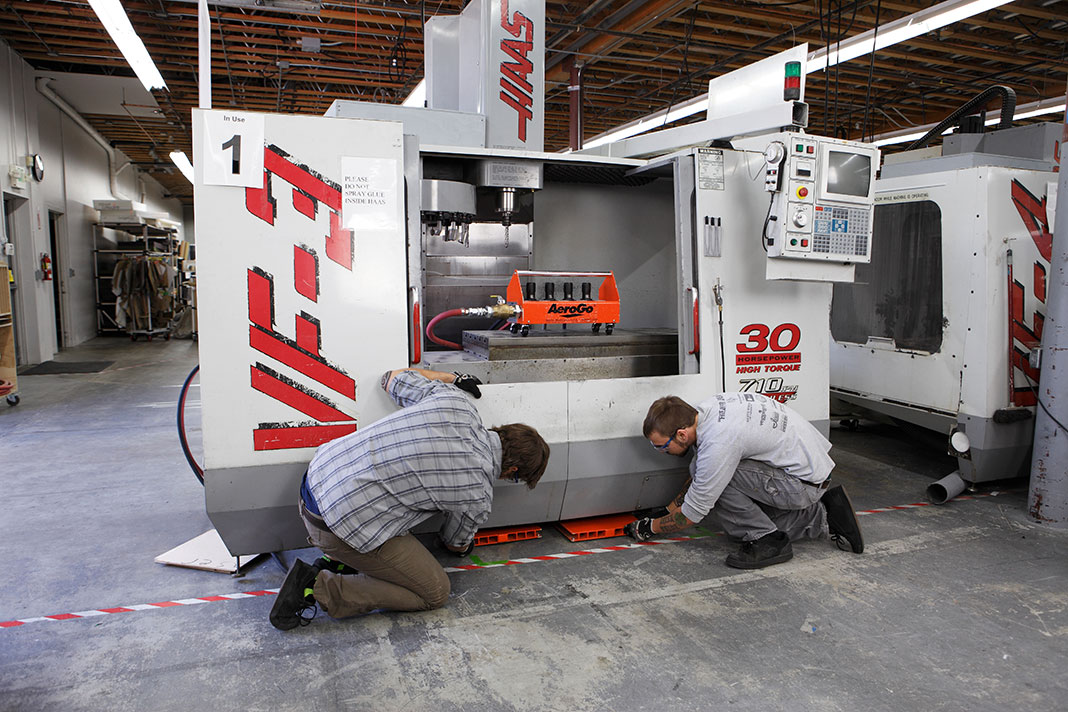There are multiple methods for keeping components moving through an assembly line.
By John Massenberg, president and CEO at AeroGo
In a manufacturing setting, there are constant needs to move heavy tooling equipment. Whether an assembly line setup or fixed machinery, moving 3,000 kilograms isn’t simply a matter of getting a bunch of guys together and pushing really hard. A mechanism and protocol is necessary to keep heavy components moving smoothly and getting them in place on time within a production cycle.
Some manufacturers keep assembly equipment stationary on the floor and then move components to the machine for assembly. Ultimately, this is one of the least efficient practices, as it requires more people working in the same space, interrupting each other and halting the flow of work. Keeping components moving through an assembly line makes for smoother and more efficient production, for which there are multiple methods.
Wheeled casters are a common method of transport—wheels are affixed to a cart and then the piece gets moved from station to station on top of the cart. The drawback, though, is that human effort is required to push these carts, and the necessary force to move that kind of weight by hand is not in line with ergonomic requirements of push and pull force. Not to mention the risk something like this can be for worker injury if proper use and safety measures are not being used.
Additionally, the facility floor must be without flaws or seams that could catch the wheels while they move. Even on a completely smooth surface, wheeled casters do not allow for the accuracy of movement and positioning that may be required for more delicate equipment.
In-floor conveyor belts alleviate some of those issues, but come with drawbacks of their own. They are extremely expensive to install and maintain, and a facility loses productivity time during that construction process. Additionally, with synchronized assembly stations, there is a first in/first out protocol, meaning any errors or issues with a single component stops the entire line.
Lifting methods such as cranes and forklifts are capable of moving heavy weight, but they too lack the precision of movement that may be necessary. They also present a significant challenge when it comes to space. Cranes themselves take up a great deal of space, and forklifts require space to maneuver and lift. Forklifts and cranes also both require certified operators, given the inherent safety concerns, and if that operator is not available, you lose valuable time.
So, what is the solution that addresses all these concerns that is the most efficient, safe and does not require special knowledge to use? Air casters.
Air casters are the clear solution that addresses all these concerns. Air casters work by inflating a pressurized disc that lifts and floats the machinery off the ground in order to move it from pace to place. Similar to an air hockey puck, the air caster floats the load weight, which makes it easy to maneuver heavy loads in every direction, unlike wheeled casters, which are fixed. That means equipment can be moved with more precision into smaller spaces.

No matter the size of the object you are moving, air casters help push equipment more easily by hand, with fewer people needed, better meeting ergonomic standards.
Air casters also require less vertical space than wheels—about two inches compared to eight to 10 inches—and can be slid flat under a piece of equipment then inflated for movement, instead of needing to be lifted and placed on top of wheels.
Additionally, the force required to move an air caster is about 1 kilogram per 1,000 kilograms of weight, so equipment can be pushed more easily by hand, with fewer people needed, better meeting ergonomic standards. When moving the equipment, there is also much lower friction, which means no damage to the floor when moving the equipment.
Once the equipment has been moved, it can be fixed in place simply by deflating the air caster to sit flat on the floor surface. This means no chance of slippage or unwanted shifting when the move is complete. Ultimately, it also means reduced employee safety and life hazards, ensuring less workplace injuries and prioritizing workers health.
Air casters are initially more expensive than standard pallet jacks or wheel casters, but cost far less than cranes and in-floor conveyor belts, and that expense can be offset by the increased productivity and efficiency they deliver. So, when considering how to move oversized, awkward, unbalanced or heavy components, air casters can mean the difference between a seamless production line and costly time sinks and interruptions.

John Massenburg
John C. Massenburg is president and CEO of AeroGo, Inc. He has directed expansion of custom engineered solutions to develop a robust and reliable transporter set of products, used throughout the world to move transformers, feed water heaters, nuclear casks, ships, caissons and myriad projects up to 5,000 tons. Under his leadership, AeroGo has grown its international presence and distributor network. Massenburg previously served for seven years as custom product group manager and director of sales and marketing. Massenburg holds an M.S. and a B.S. in Mechanical Engineering from Washington State University. Headquartered in Seattle, Washington since 1967, AeroGo is the leading Aero-Caster and air caster products manufacturing firm. More information is available online at www.aerogo.com.
In this episode, I sat down with Beejan Giga, Director | Partner and Caleb Emerson, Senior Results Manager at Carpedia International. We discussed the insights behind their recent Industry Today article, “Thinking Three Moves Ahead” and together we explored how manufacturers can plan more strategically, align with their suppliers, and build the operational discipline needed to support intentional, sustainable growth. It was a conversation packed with practical perspectives on navigating a fast-changing industry landscape.